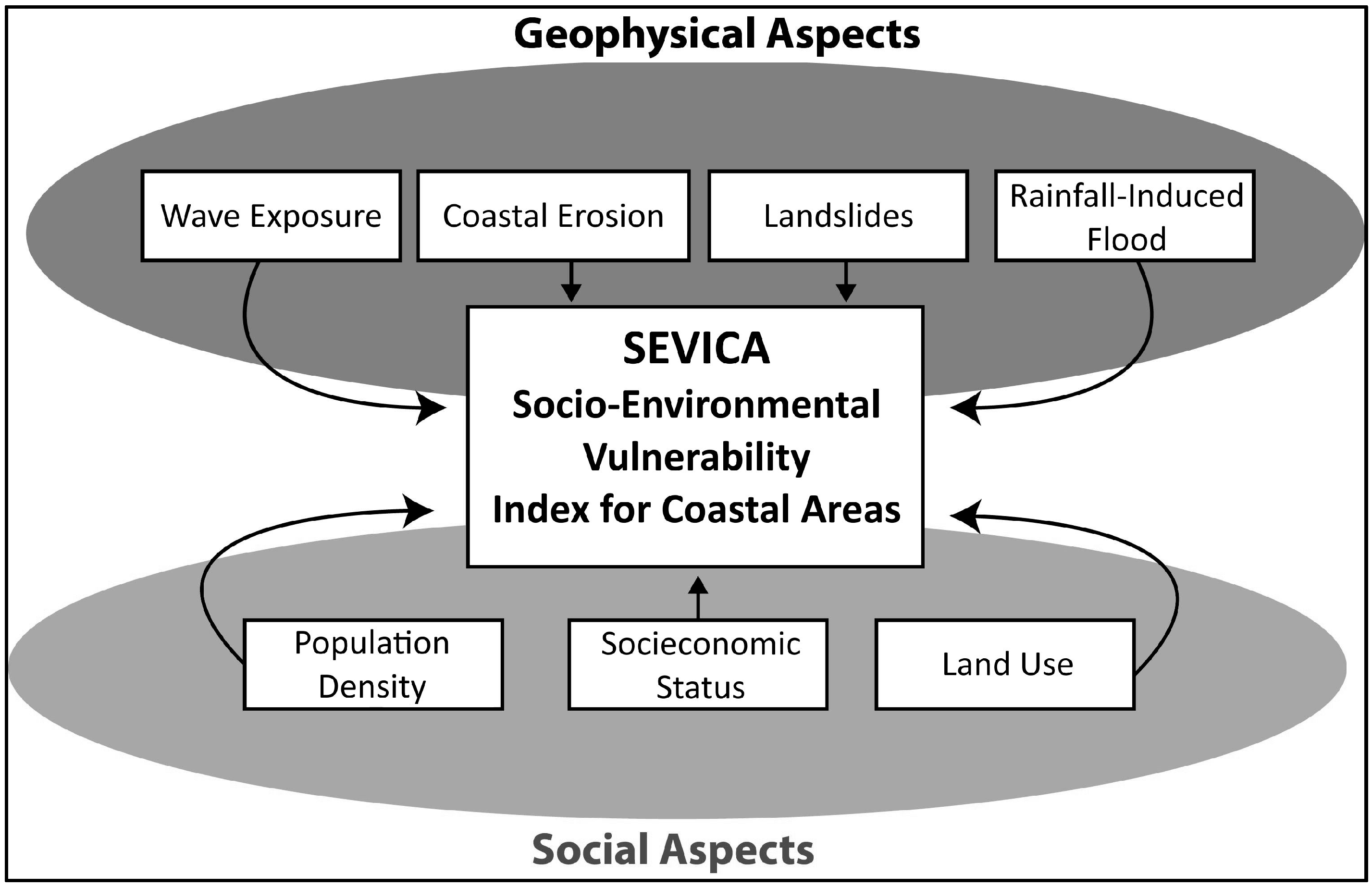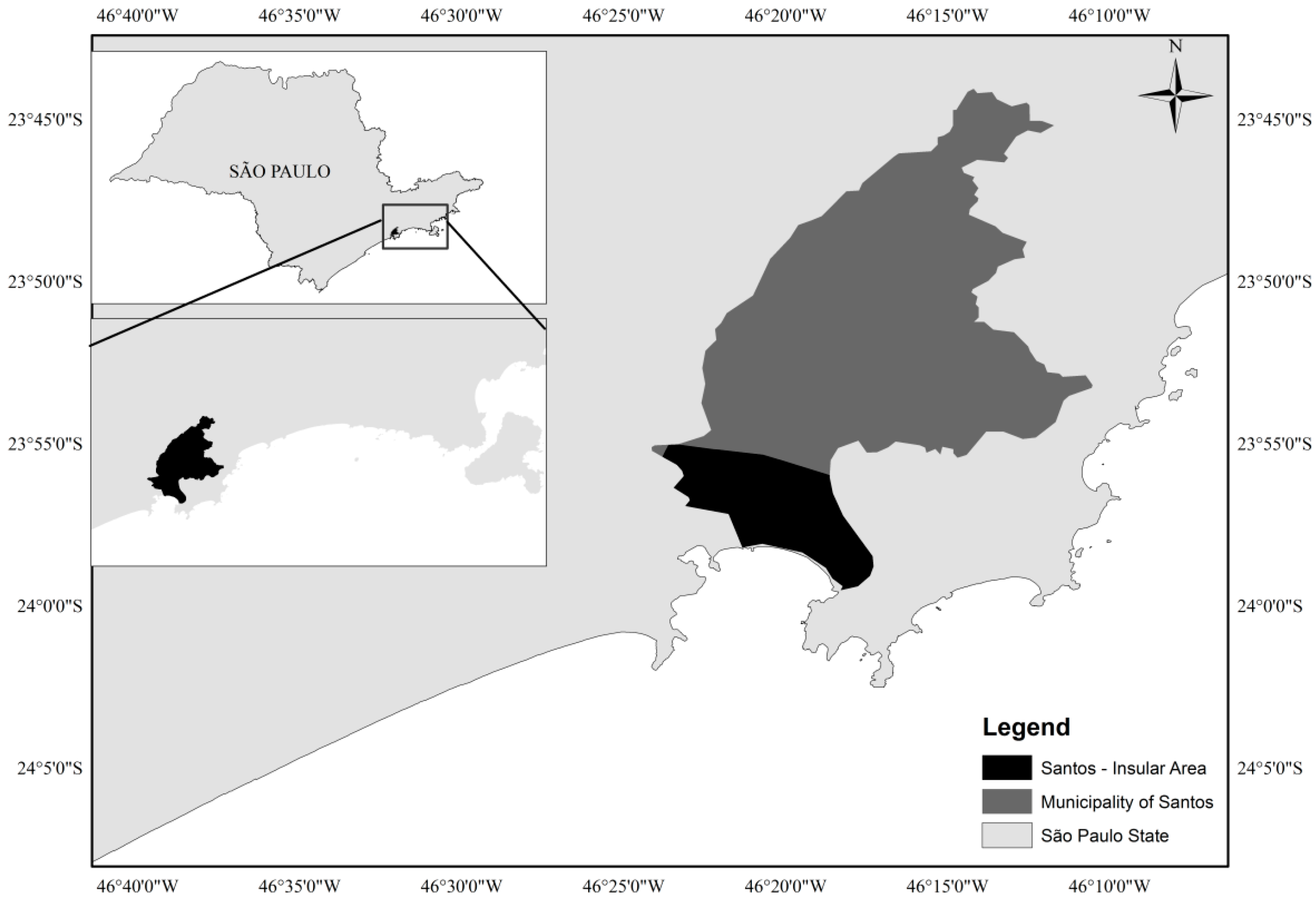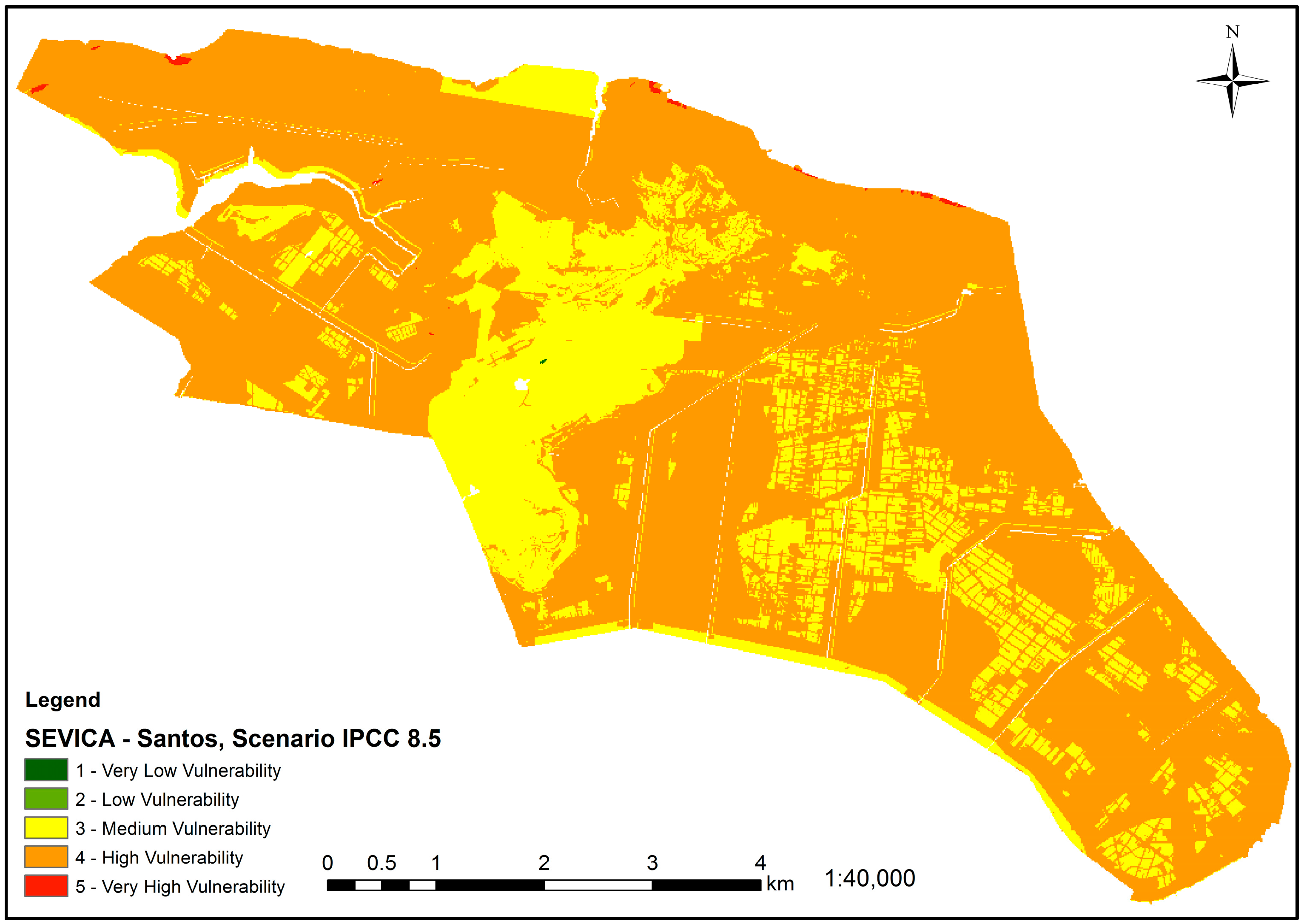A Climate Change Vulnerability Index and Case Study in a Brazilian Coastal City
Abstract
:1. Introduction
2. Vulnerability Indexes and Variables
3. Materials and Methods
Multiple Hazards Index
- Factorv = Factor’s vulnerability;
- P1—n = Parameter;
- n = number of parameters considered.
- F = Flooding factor index;
- L = Landslides factor index;
- CE = Coastal Erosion factor index;
- WE = Wave Exposition factor index;
- PD = Population Density factor index;
- SS = Socioeconomic Status factor index;
- LU = Land Use factor index;
- p = weights to each factor.
4. Case Study
Index Operationalization
- F = Flooding;
- L = Landslides;
- CE = Coastal Erosion;
- WE = Wave Exposition;
- PD = Population Density;
- SS = Socioeconomic Status;
- LU = Land Use.
5. Results and Discussion
6. Conclusions
Acknowledgments
Author Contributions
Conflicts of Interest
References
- IPCC—International Panel on Climate Changes. Climate Change: The IPCC Scientific Assessment; International Panel on Climate Changes (IPC): Cambridge, UK, 1990. [Google Scholar]
- Gornitz, V. Global Coastal Hazards from Future Sea Level Rise. Palaeogeogr. Palaeoclimatol. 1991, 89, 379–398. [Google Scholar] [CrossRef]
- Shaw, J.; Taylor, R.B.; Forbes, D.L.; Ruz, M.-H.; Solomon, S. Sensitivity of the Coasts of Canada. Geol. Surv. Can. Bull. 1998, 505. [Google Scholar] [CrossRef]
- Jabareen, Y. The Risk City. Cities Countering Climate Change: Emerging Planning Theories and Practices around the World; Lecture Notes in Energy 29; Springer: Dordrecht, The Netherlands, 2015; p. 210. [Google Scholar]
- Abuodha, P.; Woodroffe, C.D. Assessing Vulnerability of Coasts to Climate Change: A Review of Approaches and Their Application to the Australian Coast. In GIS for the Coastal Zone: A Selection of Papers from Coastgis; Woodroffe, C.D., Bruce, E., Puotinen, M., Furness, R.A., Eds.; Australian National Centre for Ocean Resources & Security, University of Wollongong: Wollongong, Australia, 2007; p. 458. [Google Scholar]
- Cutter, S.L.; Boruff, B.J.; Shirley, W.L. Social Vulnerability to Environmental Hazards. Soc. Sci. Q. 2003, 84, 242–261. [Google Scholar] [CrossRef]
- Balica, S.F.; Wright, N.G.; van Der Meulen, F. A flood vulnerability index for coastal cities and its use in assessing climate change impacts. Nat. Hazards 2012, 64, 73–105. [Google Scholar] [CrossRef]
- Alves, H.P.F. Vulnerabilidade Socioambiental Na Metrópole Paulistana: Uma Análise Sociodemográfica Das Situações de Sobreposição Espacial de Problemas e Riscos Sociais e Ambientais. Revista Brasileira de Estudos de População; Associação Brasileira de Estudos Populacionais: Rio De Janeiro, Brazil, 2006; Volume 23, pp. 43–59. (In Portuguese) [Google Scholar]
- Nicolodi, J.L.; Peterman, R.M. Climate Changes and Vulnerability of the Brazilian Coastal Zone in Its Environmental, Social, and Technological Aspects. J. Integr. Coast. Zone Manag. 2010, 10, 151–177. [Google Scholar]
- Iwama, A.Y.; Batistella, M.; Ferreira, L.C. Geotechnical Risks and Social Vulnerability in Coastal Areas: Inequalities and Climate Change. Ambiente Soc. 2014, 17, 251–274. [Google Scholar] [CrossRef]
- Furlan, A.; Bonotto, D.M.; Gumiere, S.J. Development of Environmental and Natural Vulnerability Maps for Brazilian Coastal at São Sebastião in São Paulo State. Environ. Earth Sci. 2011, 64, 659–669. [Google Scholar] [CrossRef]
- IPCC—International Panel on Climate Changes. Summary for Policy Makers. In Climate Change 2014: Impacts, Adaptation, and Vulnerability. Part A: Global and Sectoral Aspects. Contribution of Working Group II to the Fifth Assessment Report of the Intergovernmental Panel on Climate Change; Field, C.B., Barros, V.R., Dokken, D.J., Mach, K.J., Mastrandrea, M.D., Bilir, T.E., Chatterjee, M., Ebi, K.L., Estrada, Y.O., Genova, R.C., et al., Eds.; International Panel on Climate Changes (IPCC): Cambridge, UK, 2014; pp. 1–32. [Google Scholar]
- Cutter, S.L.; Mitchell, J.T.; Scott, M.S. Revealing the Vulnerability of People and Places: A Case Study of Georgetown County, South Carolina. Ann. Assoc. Am. Geogr. 2000, 90, 713–737. [Google Scholar] [CrossRef]
- Miller, F.; Osbahr, H.; Boyd, E.; Thomalla, F.; Bharwani, S.; Ziervogel, G.; Walker, B.; Birkmann, J.; Van Der Leeuw, S.; Rockström, J.; et al. Resilience And Vulnerability: Complementary or Conflicting Concepts? Ecol. Soc. 2010, 15, 11. [Google Scholar]
- Thieler, E.R.; Hammar-Klose, E.S. National Asssessment of Vulnerability to Sea-Level Rise: Preliminary Results for the U.S. Atlantic Coast; United States Geological Survey: Reston, VA, USA, 1999. [Google Scholar]
- Karymbalis, E.; Chalkias, C.; Chalkias, G.; Gigoropoulou, E.; Manthos, G.; Ferentinou, M. Assessment of the Sensitivity of the Southern Coast of the Gulf of Corinth (Peloponnese, Greece) to Sea-Level Rise. Cent. Eur. J. Geosci. 2012, 4, 561–577. [Google Scholar] [CrossRef]
- Boruff, B.J.; Emrich, C.; Cutter, S.L. Erosion Hazard Vulnerability of US Coastal Counties. J. Coast. Res. West Palm Beach (Fla.) 2015, 21, 932–942. [Google Scholar] [CrossRef]
- Wu, S.Y.; Yarnal, B.; Fischer, A. Vulnerability of Coastal Communities to Sea-Level Rise: A Case Study of Cape May County, New Jersey, USA. Clim. Res. 2002, 22, 255–270. [Google Scholar] [CrossRef]
- Chakraborty, J.; Tobin, G.A.; Montz, B.E. Population Evacuation: Assessing Spatial Variability in Geophysical Risk and Social Vulnerability to Natural Hazards. Nat. Hazards Rev. Am. Soc. Civ. Eng. 2005, 6, 23–33. [Google Scholar] [CrossRef]
- Li, K.; Li, G.S. Vulnerability Assessment of Storm Surges in the Coastal Area of Guangdong Province. Nat. Hazards Earth Syst. Sci. 2011, 11, 2003–2010. [Google Scholar] [CrossRef]
- Adger, W.N. Vulnerability. Glob. Environ. Chang. 2006, 16, 268–281. [Google Scholar] [CrossRef]
- Füssel, H.M.; Klein, R.J.T. Climate Change Vulnerability Assessment: An Evolution of Conceptual Thinking. Clim. Chang. 2006, 75, 301–329. [Google Scholar] [CrossRef]
- O’brien, K.L.; Eriksen, S.; Nygaard, L.P.; Schjolden, A. Why Different Interpretations of Vulnerability Matter in Climate Change Discourses. Clim. Policy 2007, 7, 73–88. [Google Scholar] [CrossRef]
- Inouye, C.E.N.; Sousa, W.C., Jr.; Freitas, D.M.; Simões, E. Modelling the Spatial Dynamics of Urban Growth and Land Use Changes in the North Coast of São Paulo, Brazil. Ocean Coast. Manag. 2015, 108, 147–157. [Google Scholar] [CrossRef]
- Sharp, R.; Tallis, H.T.; Ricketts, T.; Guerry, A.D.; Wood, S.A.; Chaplin-Kramer, R.; Nelson, E.; Ennaanay, D.; Wolny, S.; Olwero, N.; et al. Invest User’s Guide, 2014. Available online: http://data.naturalcapitalproject.org/nightly-build/invest-users-guide/html/ (accessed on 13 July 2016).
- Anazawa, T.M.; Feitosa, F.F.; Monteiro, A.M.V. Vulnerabilidade Socioecológica No Litoral Norte de São Paulo: Medidas, Superfícies e Perfis de Ativos. Geografia 2012, 38, 189–208. (In Portuguese) [Google Scholar]
- IBGE—Instituto Brasileiro De Geografia E Estatística. Atlas Do Censo Demográfico 2010; IBGE: Brasília, Brazil, 2013. (In Portuguese) [Google Scholar]
- IPCC—International Panel on Climate Changes. Summary for Policymakers. In Climate Change 2013: The Physical Science Basis. Contribution of Working Group I to the Fifth Assessment Report of the Intergovernmental Panel on Climate Change; Stocker, T.F., Qin, D., Plattner, G.-K., Tignor, M., Allen, S.K., Boschung, J., Nauels, A., Xia, Y., Bex, V., Midgley, P.M., Eds.; International Panel on Climate Changes (IPCC): Cambridge, UK, 2013; pp. 1–32. [Google Scholar]
- Chou, S.; Lyra, A.; Mourão, C.; Dereczynski, C.; Pilotto, I.; Gomes, J.; Bustamante, J.; Tavares, P.; Silva, A.; Rodrigues, D.; et al. Evaluation of the Eta Simulations Nested in Three Global Climate Models. Am. J. Clim. Chang. 2014, 3, 438–454. [Google Scholar] [CrossRef]
- Chou, S.C.; Pilotto, I.L.; Nobre, P. Seasonal Climate Hindcasts with Eta Model Nested in Cptec Coupled Ocean Atmosphere General Circulation Model. Theor. Appl. Climatol. V 2012, 110, 437–456. [Google Scholar]
- IPT—Instituto de Pesquisas Tecnológicas do Estado de São Paulo. Cartas de Suscetibilidade a Movimentos Gravitacionais de Massa e Inundações—1:25.000; IPT: São Paulo, Brazil, 2014. (In Portuguese) [Google Scholar]
- Valeriano, M.M. Modelo Digital de Variáveis Morfométricas Com Dados Srtm Para O Território Nacional: O Projeto Topodata. In XII Simpósio Brasileiro de Sensoriamento Remoto, 2005, Goiânia, Go. Anais Do XII Simpósio Brasileiro de Sensoriamento Remoto; XII Simpósio Brasileiro de Sensoriamento Remoto (XII SBSR): Goiania, Brazil, 2005; pp. 1–8. (In Portuguese) [Google Scholar]
- Valeriano, M.M.; Rossetti, D.F.; Albuquerque, P.C.G. Topodata: Desenvolvimento da Primeira Versão Do Banco de Dados Geomorfométricos Locais Em Cobertura Nacional. In Simpósio Brasileiro de Sensoriamento Remoto, 2009, Natal, Rn; XIV Simpósio Brasileiro de Sensoriamento Remoto (XIV SBSR): São José dos Campos, Brazil, 2009; pp. 1–8. (In Portuguese) [Google Scholar]




| Vulnerability Concept | Index Name | Variables/Parameters/Factors | Reference |
|---|---|---|---|
| Geophysical | CVI | Relief, geomorphology, rock type, vertical sea level movement, shoreline displacement, tidal range, wave height | [2] |
| SI | Relief, rock type, geomorphology, sea level tendency, shoreline displacement rate, mean tidal range, mean annual maximum significant wave height | [3] | |
| CVI | Geomorphology, coastal slope, relative sea-level rise rate, shoreline erosion/accretion rate, mean tide range, mean wave height | [15] | |
| CSI | CVI (Thieler e Hammar-Klose,1999) | [16] | |
| Social | SoVI | Personal Wealth, age, density of the built environment, single-sector economic dependence, housing stock and tenancy, race—African American, race—Native American, race—Asian, occupation, infrastructure dependence | [6] |
| CsoVI | Poverty, age, development density, Asian and immigrants, rural/urban dichotomy, race and gender, population decline, ethnicity (Indian) and farming, infrastructure employment reliance, income | [15] | |
| Socio-Environmental | PVI | CVI (Thieler e Hammar-Klose,1999) + CsoVI | [17] |
| N.D | Flood-risk zones, population, housing units, females, ethnic population, young (under 18), elderly (age over 60), single mother households, renter-occupied housing units | [18] | |
| N.D | Flooding risk, population and structure, differential access to resources, population with special evacuation needs | [19] | |
| N.D | Socioeconomic index, land use index, eco-environmental index, coastal construction index, disaster-bearing capability index | [20] | |
| N.D | Sea level rise, storm surge, number of cyclones in the last 5 years, river discharge, foreshore slope, soil subsidence, km of coastline, population close to coastline, percentile of disabled persons, shelters, cultural heritage, awareness and preparedness, km of drainage, growing coastal population, recovery time, uncontrolled planning zones, flood hazard maps, institutional organizations, flood protection | [7] |
| Factor | Parameters | Source of Data |
|---|---|---|
| Flooding (F) | Slope (S) | DEM |
| Number of Extreme Events (NEE) | Climatic Models, Meteorological Data | |
| Water Body Proximity (WBP) | Hydrography Maps | |
| Landslides (L) | Slope (S) | DEM |
| Number of Extreme Events (NEE) | Climatic Models, Meteorological Data | |
| Geotechnical Classification of Soil(GCS) | Geology institutes, Mineralogy institutes, or Engineering Institutes | |
| Coastal Erosion (CE) | Geomorphology (G) | Geology institutes, Mineralogy institutes, or Engineering Institutes |
| SLR (SLR) | IPCC, Sea Level Rise Models | |
| Tide Height (TH) | Oceanography institutes, Navy | |
| Wave Exposition (WE) | SLR (SLR) | IPCC, Sea Level Rise Models |
| Relief (R) | DEM | |
| Distance of the coast (DC) | Geopolitical Maps | |
| Socioeconomic Status (SS) | Education Level (EL) | Nacional or Regional Census |
| Income (I) | Nacional or Regional Census | |
| Population Density (PD) | Population Density (DENS) | Nacional or Regional Census |
| Age (A) | Nacional or Regional Census | |
| Land Use (LU) | Land Use (USE) | Local Government |
| Factor | Parameter/Classification | 1 | 2 | 3 | 4 | 5 | Reference |
|---|---|---|---|---|---|---|---|
| Landslide | Number of Extreme Events in the last 10 years (NEE) | ≤3 events | ≤10 events | ≤20 events | ≤36 events | >36 events | Adapted from [7] |
| Geotechnical Classification of Soil (GCS) | Bedrock | Tertiary non-expansive soil, fractured rock with rugous surface | Laterite soils, sandy soil | Alluvial (quaternary), fractured rock with clean ruptures filled with clays | Colluvium and talus body, expansive Soils | Expert elicitation | |
| Slope (S) | ≤20% | ≤40% | ≤60% | ≤80% | >80% | Adapted from [25] | |
| Flooding | Number of Extreme Events in the last 10 years (NEE) | ≤3 events | ≤10 events | ≤20 events | ≤36 events | >36 events | Adapted from [7] |
| Slope (S) | ≥80% | ≥60% | ≥40% | ≥20% | <20% | Adapted from [25] | |
| Water Body Proximity (WBP) | >150 m | >100 m | >50 m | >20 m | ≤10 m | Adapted from [26] | |
| Wave Exposure | Sea Level Rise (SLR) | ≤0 m | ≤0.3 m | ≤0.5 m | ≤0.7 m | ≤0.9 m | Adapted from [25] |
| Relief (R) | > 50 m | >20 m | >10 m | >5 m | ≤1 m | Adapted from [24] | |
| Distance of the coast (DC) | >150 m | >100 m | >50 m | >20 m | ≤10 m | Adapted from [26] | |
| Coastal Erosion | Sea Level Rise (SLR) | ≤0 m | ≤0.3 m | ≤0.5 m | ≤0.7 m | ≤0.9 m | Adapted from [25] |
| Geomorphology (G) | Rocky, high cliffs, seawalls | Medium cliffs and indented coast, bulkhead | Low cliffs, alluvial plain | Cobble beach, estuary, lagoon | Sand beach, mud flat, delta | Adapted from [25] | |
| Tide Height (TH) | ≤0.5 m | ≤1 m | ≤1.5 m | ≤2.0 m | ≤2.5 m | Adapted from [15] | |
| Population Density | Population Density (DENS) | ≤5000 | ≤10,000 | ≤50,000 | ≤100,000 | >100,000 | Elaborated by authors |
| Age (A) | 25–30 years old | 35–40 years old | 15–20 years old and 40–50 years old | 5–15 years old and 50–60 years old | 0–5 years old and more than 60 years old | Adapted from [6] | |
| Socio-economic level | Income (I) | >20 LMW | up to 20 LMW | up to 10 LMW | up to 5 LMW | up to 2 LMW | Adapted from [8] |
| Education Level (EL) | Graduated or higher | Undergraduated | College | High School | Elementary school or less. | Adapted from [8] | |
| Land Use | Land Use (USE) | Environmental protection area or natural habitat | Rural Area | Residential Area | Commercial Area | Industrial Area | Elaborated by authors. |
| Factor | Parameter | Data Source |
|---|---|---|
| Landslide (L) | Number of Extreme Events in the last 10 years (NEE) | ETA-CPTEC/INPE, Brazil [29,30] |
| Geotechnical Classification of Soil (GCS) | IPT [31] | |
| Slope (S) | Topodata [32,33] | |
| Flooding (F) | Number of Extreme Events in the last 10 years (NEE) | ETA-CPTEC/INPE, Brazil [29,30] |
| Slope (S) | Topodata [32,33] | |
| Water Body Proximity (WBP) | IPT [31] | |
| Wave Exp (WE) | Sea Level Rise (SLR) | IPCC AR5 [28] |
| Relief (R) | Topodata [32,33] | |
| Distance of the Coast (DC) | Elaborated by authors. | |
| Coastal Erosion (CE) | Sea Level Rise (SLR) | IPCC AR5 [28] |
| Geomorphology (G) | IPT [31] | |
| Tide Height (TH) | Elaborated by authors. | |
| Populaton Density (PD) | Population Density (DENS) | Brazilian Census [27] |
| Age (A) | Brazilian Census [27] | |
| Socioeconomic Status (SS) | Income (I) | Brazilian Census [27] |
| Education Level (EL) | Brazilian Census [27] | |
| Land Use (LU) | Land Use (USE) | Santos master plan * |
© 2016 by the authors; licensee MDPI, Basel, Switzerland. This article is an open access article distributed under the terms and conditions of the Creative Commons Attribution (CC-BY) license (http://creativecommons.org/licenses/by/4.0/).
Share and Cite
Zanetti, V.B.; De Sousa Junior, W.C.; De Freitas, D.M. A Climate Change Vulnerability Index and Case Study in a Brazilian Coastal City. Sustainability 2016, 8, 811. https://doi.org/10.3390/su8080811
Zanetti VB, De Sousa Junior WC, De Freitas DM. A Climate Change Vulnerability Index and Case Study in a Brazilian Coastal City. Sustainability. 2016; 8(8):811. https://doi.org/10.3390/su8080811
Chicago/Turabian StyleZanetti, Vitor Baccarin, Wilson Cabral De Sousa Junior, and Débora M. De Freitas. 2016. "A Climate Change Vulnerability Index and Case Study in a Brazilian Coastal City" Sustainability 8, no. 8: 811. https://doi.org/10.3390/su8080811






